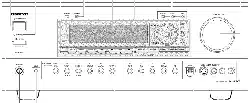Loading ...
Loading ...
Loading ...

Input Setup
Input source signals
a. Analog/PCM
Analog sources consist of LP records, FM and AM broadcasts,
cassette tapes, and the such. PCM (Pulse Code Modulation) is one
form of digital audio signals and is recorded directly onto compact
discs and DVDs without compression.
b. PCM fs=96k
Set a listening mode for the input signal from digital PCM sources
recorded with a sampling rate of 96 kHz.
e. Dolby D (Dolby Digital)
Digital data with AC-3 compression and a maximum of 5.1-channel
surround sound. This source signal comes from DVDs and LDs that
have the m_ mark and therefore recorded for 5,l-channel output.
This source also comes from digital satellite broadcasts that support
Do[by Digital.
Dialog norm
Dialogue Normalization (Dialog Norm) is feature of Dolby
Digital. When playing back software that has been encoded in
Dolby Digital, sometimes you may see a brief message in the
front panel display that read Dialog Norm xdB ("x" being a
nmneric value). Dialogue Normalization serves m let you know
if the source material has been recorded at a higher or lower level
than usual. For example, if you see the message "Dialog Norm:
+4" in the front panel display, to keep the overall output level
constant just turn down the volume control by 4dB. In other
words, the source material that you are listening Io has been
recorded 4dB louder than usual If you do no1 see a message,
then no adjustment of the volume control is necessary.
r% • _ "1 _ .-'I L I -- .. a i .q
L': " "-- -': --'L-- ."'q "..i''..":" = ....u:....:
d. DTS
DTS (Digital Theater System) is compressed digital data with a
maximum 5.1-channel surround output that allows for an extremely
high-quality sound. This source signal requires a DVD player that
supports DTS output and comes from DVDs, compact discs, and
LDs thai have the _ mark.
f. D.F. 2 ch (Digital Format 2 channel)
2 channel digital signal (except for PCM) such as Dolby Digital.
DVD or LD in which the 2 channel sound are recorded may be this
type of input signal.
g. D.F. Mono (Digital Format Monaural)
Monaural digital signal (except for PCM) such as Do[by Digital.
DVD or LD in which the monaural sound are recorded may be this
type of input signal
Listening Modes
Mono
This mode is for playing old movies whose sound is recorded in
monaural or playing lefl and right channels separately in the movies
which contains the different language signals recorded into
individual channels. This mode also allows you to listen to the
multiplexed soundtracks on DVDs, and other media that have them.
Direct
This mode delivers pure sound with minimmn sound quality
adjustment and filtration, The sound recorded for the right and lefl
front channels is oulput to the right and left front speakez:s only and
not output Io the subwoofer.
Stereo
This mode has all input sound is output from the lefl and right front
speakers.
Subwoofer also can be used for playback.
T-D (Theater-Dimensional)
For the best enjoyment of your home theater, it is recommended that
you have at least front left and right speakers, a center speaker, and
surround left and right speakers. However, if you only have front lefl
and right speakers, you can enjoy multichannel audio by using this
mode.
This mode controls the characteristics of the sound that reaches each
ear to reproduce a multi-speaker setup. To receive the full effect,
there is an optimum listening position (sweet spot)_ Refer to the
explanation of the listening angle. In addition, if the reflective sound
components are large, it may be difficult to achieve the desired
result, so be sure to set up your system and listening position to
minimize reflective sound.
DOLBY PRO LOGIC II
This mode is a new generation 5-channel surround system that
provides performance between the 4-channel (left front, right front,
center, and monaural surround) Pro Logic Surround and the 5.1-
channel Dolby Digital Surround. This mode can be set to the Movie
mode designed for playing movies and the Music mode designed for
listening to music. In the Movie mode, the sun'ound channels, which
used to provide monaural output over only a narrow frequency
range, now provide complete stereo output over the full frequency
range. The result is movie viewing with a realistic feel of movement.
The Music mode uses the surround channels 1o provide a natural
sound space that cannot be provided with normal stereo output.
This mode can be used with VHS and DVD videos with the
I'I3_ mark and certain television programs. The Music mode
can be used with music compact discs and o_her stereo sources.
If no sm'round speakers are connected, then the surround sound is
divided and oulput from the front left and right channels (3 stereo).
Dolby D (Dolby Digital)
Used for playing Dolby Digital source.
38
Loading ...
Loading ...
Loading ...
